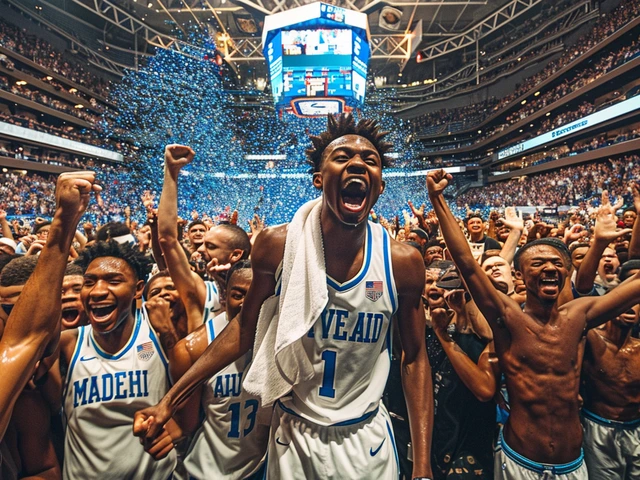The Evolution of Synchronized Swimming: From Graceful Art to High-Impact Sport

The Evolution of Synchronized Swimming
Synchronized swimming, a sport long known for its elegance and precise movements, has undergone a transformation that might surprise many sports enthusiasts. Now officially rebranded as artistic swimming, this sport is no longer just about grace and synchronization; it has evolved into a highly competitive and physically demanding discipline. The changes are particularly significant as we approach the 2024 Paris Olympics, where viewers will witness the sport's new face.
The renaming to 'artistic swimming' wasn't just a marketing move. It represents a profound shift in the sport's identity, intending to better reflect the blend of artistic expression and athleticism that defines it today. The routines now incorporate elements that push the boundaries of human strength, flexibility, and coordination. These changes aim not only to challenge the athletes but also to captivate a global audience that craves excitement and novelty in sports.
The New Athleticism
One of the most noticeable changes in artistic swimming is the physicality of the athletes. Gone are the days when synchronized swimmers were primarily judged on their elegance and grace. Today, the sport demands a combination of muscle power and artistic finesse. Athletes are performing increasingly complex and risky maneuvers, requiring a level of strength and endurance akin to traditional high-impact sports.
These new routines demand more than synchronized movements; they require athletes to execute lifts, throws, and spins that would have been unimaginable a decade ago. This evolution is designed to make the sport more thrilling and unpredictable, both for participants and spectators. As the routines become more complicated, the physical risks also increase, making the sport more dangerous. Despite these dangers, the athletes remain undeterred, driven by the challenge and the opportunity to showcase their abilities on the world stage.
A New Judging System
Another significant change in artistic swimming is the introduction of a new judging system. The new criteria aim to reduce the subjectivity that has long been a point of contention in the sport. The athletes are now scored on three main aspects: technical execution, synchronization, and artistic impression. Technical execution assesses the precision and difficulty of the movements, while synchronization focuses on the harmony between team members. The artistic impression category evaluates the creativity, musicality, and overall presentation of the routine.
This new system intends to bring a greater level of fairness and transparency to the sport. It ensures that the athletes' hard work and innovation are adequately recognized, and it provides clearer guidelines for both competitors and judges. By minimizing subjectivity, the sport can maintain its artistic roots while embracing the rigorous standards of athletic competition.
Breaking Gender Barriers
The 2024 Paris Olympics will also be a milestone for artistic swimming in terms of gender representation. Historically, synchronized swimming has been dominated by female athletes. However, the upcoming Olympics will feature male competitors in the team events for the first time. This inclusion marks a significant step towards gender inclusivity in a sport that has traditionally been viewed through a very narrow lens.
Male athletes bring a different set of strengths and stylistic elements to the sport, making the routines even more dynamic and diverse. Their participation not only provides new opportunities for male swimmers but also enriches the sport's competitive landscape. This change is warmly welcomed by many in the artistic swimming community, who see it as a progressive step towards a more inclusive and representative sport.
Historical Context: From Dominance to Diversity
In the history of synchronized swimming, the sport has seen various phases of dominance by different nations. In the early days, the USA and Canada were considered the powerhouses of synchronized swimming, consistently winning medals and setting the standards for excellence. However, in recent years, the Russian Olympic Committee has taken the lead, demonstrating unparalleled skill and innovation in the sport.
This shift in dominance reflects the evolving nature of artistic swimming. It also showcases the increasing competitiveness of the sport on a global scale. Countries are investing more in training and developing their athletes, resulting in a more diverse and unpredictable competition. This diversity is a testament to the sport's growing appeal and the continuous drive for excellence among its participants.
The Future of Artistic Swimming
As artistic swimming continues to evolve, it promises to captivate audiences with its blend of athleticism and artistry. The upcoming 2024 Paris Olympics will be an exciting showcase of the sport's new direction, highlighting not only the enhanced physical demands but also the creative and expressive potential of the athletes. With new judging criteria and the inclusion of male competitors, artistic swimming is poised to reach new heights of popularity and recognition.
For the athletes, the journey is one of constant growth and adaptation. They must continually push their limits, both physically and creatively, to stay competitive. For the spectators, the evolution of artistic swimming offers a more thrilling and engaging experience, one that celebrates the incredible capabilities of the human body and spirit. As we look forward to the 2024 Paris Olympics, one thing is certain: artistic swimming will continue to inspire and amaze, both as a sport and an art form.






Jordan Bowens
August 5, 2024 AT 18:16Artistic swimming? Just a splashy show with a side of cardio.
Kimberly Hickam
August 10, 2024 AT 05:10When you look at the trajectory of artistic swimming over the past decade, you can almost hear the echo of an ancient chorus singing about the relentless march of progress. The sport, once cloaked in the delicate veils of ballet and water, now strides onto the arena with the swagger of a heavyweight champion, demanding both aesthetic grace and raw power. It is as if the pool has become a crucible where muscles are forged and artistic souls are tempered, a place where the line between dancer and athlete blurs beyond recognition. One cannot ignore the seismic shift that the new judging criteria introduce, slicing through the fog of subjectivity like a surgeon's scalpel. Technical execution, synchronization, and artistic impression now form a tripod, each leg required to stand firm, lest the routine collapse under the weight of expectations. The inclusion of male swimmers adds another layer to this complex tapestry, weaving threads of strength and diversity into the fabric of the performance. Yet, as we celebrate this evolution, we must question whether the sport's soul is being diluted in the pursuit of spectacle, or whether it is simply shedding an outdated skin. The rise of high-impact lifts and throws, once the domain of gymnastics, forces us to reconsider the very definition of aquatic choreography. Audiences, accustomed to the gentle ripple of synchronized swimmers, now witness thunderous splashes that reverberate like drumbeats in a stadium. Such a transformation inevitably brings risk, and with risk comes the inevitable debate over safety versus entertainment. Coaches, no longer content with mere elegance, are now engineers of power, designing routines that test the limits of human physiology. The global competition, once dominated by a handful of nations, has blossomed into a vibrant garden where new contenders sprout from unexpected soils. Russia's dominance, while still formidable, is now challenged by emerging powers that bring fresh perspectives and daring innovations. In the end, the sport stands at a crossroads, balancing on the thin line between art and sport, tradition and transformation. Whether we, as spectators, will embrace this metamorphosis or cling to nostalgic ideals remains the true test of our collective taste. Perhaps the ultimate lesson is that progress, like water, finds its own path, carving new channels where once there were none.
Gift OLUWASANMI
August 14, 2024 AT 16:05Oh, the so‑called "evolution" is nothing more than a glitter‑coated gimmick, a desperate attempt to lure streaming platforms with flashier lifts while the core discipline drowns in pretentious hype. The new judging rubric reads like a bureaucrat’s fever dream, tossing artistic nuance aside for cold, calculable metrics. Those who applaud the inclusion of men seem to forget that synchronized swimming was historically a celebration of femininity, a delicate dance that now risks being overrun by brute power. In short, the sport is trading soul for spectacle, and it’s a bargain nobody should celebrate.
Keith Craft
August 19, 2024 AT 02:59Behold! The pool becomes a battlefield where tears of joy mix with the salt of sweat, and each lift echoes like a soliloquy of broken hearts. The drama of a thousand choruses swells beneath the surface, and even the sternest judges can’t help but feel the pang of poetic tragedy. Yet, amidst the glitter and the grind, the very water seems to weep for a time when elegance reigned supreme.
Kara Withers
August 23, 2024 AT 13:54For those curious about the revamped scoring, it now breaks down into three clear pillars: technical execution, synchronization, and artistic impression. Technical execution judges the difficulty and precision of each move, so athletes are pushing harder than ever with complex lifts and throws. Synchronization still rewards perfect timing between teammates, which remains a cornerstone of the sport’s heritage. Artistic impression evaluates choreography, musicality, and overall presentation, encouraging swimmers to blend athletic feats with creative storytelling. Understanding these categories can help fans appreciate the nuance behind each flawless routine.
boy george
August 28, 2024 AT 00:48Indeed the points are clear.
Cheryl Dixon
September 1, 2024 AT 11:43While many hail the influx of men as progress, one could argue that the very essence of synchronized swimming lies in its feminine grace, now endangered by brute force. The sport’s historical narrative is intertwined with the aesthetic of delicacy, a narrative that risks being overwritten by a new, louder chorus. It is not that male athletes lack skill; rather, the balance between strength and subtlety may shift in ways that alter the sport’s identity.
Ramesh Modi
September 5, 2024 AT 22:37Listen up, dear spectators!!! The evolution of artistic swimming is not merely a trend, it is a moral imperative-an awakening of the human spirit! By embracing strength, flexibility, and daring, we shatter outdated stereotypes, and we forge a future where gender lines dissolve like mist over the water! This is not a gimmick; it is a call to conscience, a reverberating splash that demands respect!!!
Ghanshyam Shinde
September 10, 2024 AT 09:32Oh great, another gender quota, because that's exactly what the sport needed-more paperwork and less genuine competition.
Charlotte Louise Brazier
September 14, 2024 AT 20:26We must stand united and celebrate every ripple, for inclusion is the tide that lifts us all! Let’s champion diversity in the pool and show that strength comes in every shape, gender, and style.
SAI JENA
September 19, 2024 AT 07:21The forthcoming Olympic stage offers athletes an unparalleled platform to demonstrate dedication, and I encourage each competitor to embrace rigorous preparation, mental resilience, and collaborative spirit.
Donny Evason
September 23, 2024 AT 18:15In the grand tapestry of human endeavor, the water's surface reflects our collective ambition, and only through bold discourse can we navigate its depths, forging a path where art and sport converge.